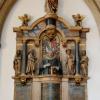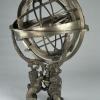Refurbishing Duke Humphrey's, 1598-1602
The room depicted in this image would have been very familiar to Thomas Bodley when the refurbished Library was opened by the Vice-Chancellor on 8 November 1602. The discrete brass lighting is of course modern, as are the chairs; and the largely fictitious portraits of college founders are a later addition. But the main furniture of the room – the book presses and their contents, modelled on the design originating a decade earlier in Merton – have not been significantly altered, nor has the endless repetition of the University’s coat of arms on the painted ceiling.
The individual volumes in this room likewise retain their original order on the shelves, and can still be found with reference to the first published catalogue of the Bodleian Library printed in 1605. But the way in which the volumes are presented has been inverted. Originally, the books were inserted into the shelves spine first. The shelfmark was written across the fore-edges of the textblock of each volume, and a clasp on the lower corner of the front cover was chained to a metal rail running along the shelf below. This arrangement, carried over from medieval manuscript libraries, allowed these costly volumes to be consulted on the reading desks provided, but not removed from their fixed places. This arrangement can still be studied in the library of Hereford Cathedral (image 4 and the BBC video listed in External Links). In Loggan’s engraving of 1675 (image 3), the chains can also be seen hanging from the folio volumes on the lower shelves of Arts End, which are also equipped with desks and benches, on which a scholar is sitting and reading. A small collection of chained books can still be found in the southwestern corner of Arts End.
This convention of displaying books with their fore-edges outward is repeated in Sir Thomas Bodley’s alabaster and marble funerary monument in Merton College Chapel (image 5). In this case, the carver, Nicholas Stone, has also included the ribbons and brass clasps sometimes fitted to fix books shut. The monument is framed by pilasters to left and right composed of stacks of books. This allusion to Bodley’s status as the builder of a house for books typifies the rich symbolism of the work as a whole. Bodley is depicted as a scholar rather than a diplomat: with an academic gown over his doublet, and a plain broad collar rather than a lace one. The seated female figure at the bottom, holding a golden key, represents Grammar, the key to all high learning, which is accessed via the ascending stair in the archway in front of her. The books behind her to the right are the grammarians, Donatus, Diomedes, and Priscianus. The oval recess above, containing the frontal bust of Bodley himself, is surrounded by four further figures representing Music, Arithmetic, Grammar and Rhetoric, the first pair standing for the quadrivium, the second for the trivium of the seven liberal arts. The figure standing on the plinth to the left holds another book, which promises that Bodley's name will not be erased from the Book of Life ('NON DELEBO NOMEN EIVS DE LIBRO VITAE'). Further information on and images of the monument is available here, together with material on the bust of Bodley (1605) in the Bodleian Library. More on this disciplinary hierarchy can be found here.
Commentary. Howard Hotson, September 2016
Sources: Sherwood and Pevsner, Oxfordshire, 162, 186-7, 262; Rogers, Bodleian Library, plates 38, 43, 46; Tyacke, Oxford: An Architectural Guide, 86-7, 90.


